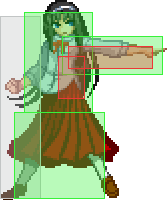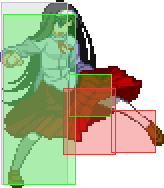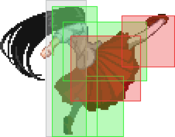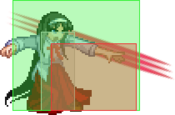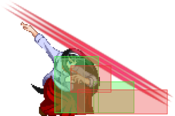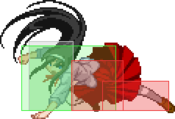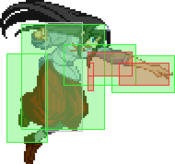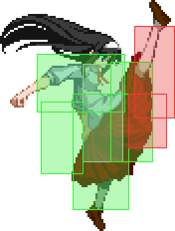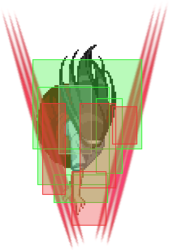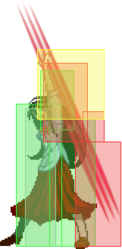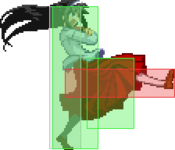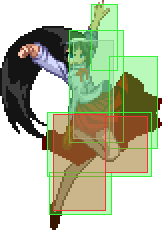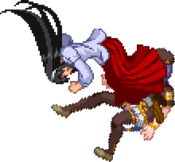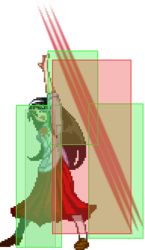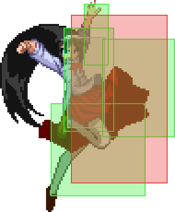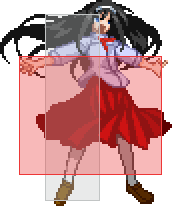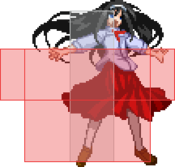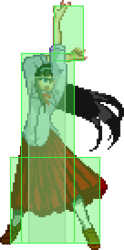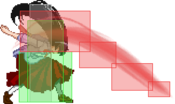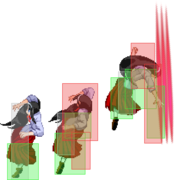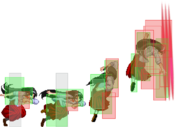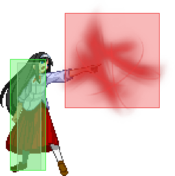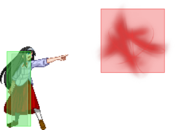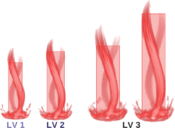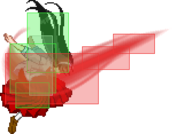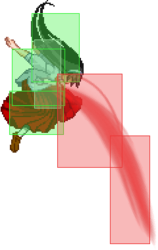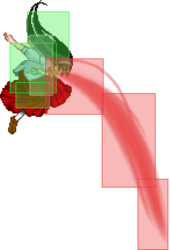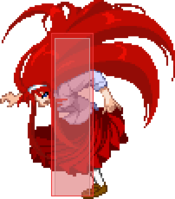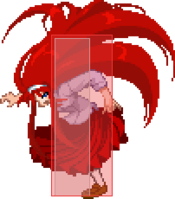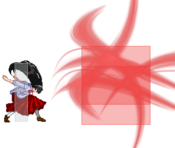Melty Blood/MBAACC/Akiha Tohno/Full Moon
Character Page Progress
This page is mostly complete, consider joining as an editor to help finish it up. Please update this character's roadmap page when one of the editing goals have been reached.
| In Progress | To-do |
|---|---|
|
|
Additional resources
F-Akiha Match Video Database
F-Akiha combo compilations not shown on wiki
F-akiha Essential combos
Notable Players
| Name | Color | Region | Common Venues | Status | Details |
|---|---|---|---|---|---|
| GO1 | Japan | A-cho | Inactive | Grandfather of Melty. Inactive.... | |
| KFL | North America | Netplay | Active | Veteran Player. Found in Meltycord under a different user name: "it's me f6zQYGeTi2YqlrU3#0705 " | |
| MakotoFox | North America | Next Level, Netplay | Active | AKA F O X. Veteran player who still plays somewhat actively casually, but can mostly be seen doing commentary. Also a VTuber. | |
| Manabe (眞鍋#0927) |
North America | Netplay | Inactive | Found in Meltycord and the Melty Blood Community Server. Veteran player. | |
| nigo (にごー) |
Japan | A-cho, Port 24 Yagoto | Active | One of the two best active Akiha players in Japan. Plays both F & C-Akiha. | |
| Pluot | North America | Netplay | Inactive | Veteran player. Current owner of Meltycord. | |
| Ryuzlin | Brazil | Netplay | Inactive | ||
| Yume (夢) | Japan | A-cho | Active | One of the two best active Akiha players in Japan. | |
| Zay | North America | Netplay | Active | Strongest active F-Akiha player in North America. |
Players to ask in the community
Opinions may differ between players and not all may agree on the same topic.
| Name | Discord username | Languages | Servers |
|---|---|---|---|
| Zay | isaiaerz | English | Meltycord, MBCS |
| Cadenza | spicat. | English, Spanish | Melty Sud, Reverse Beat Brasil |
Overview
| Strengths |
|
| Weaknesses |
|
F-Akiha, a character known primarily because of GO1, is one of the main protagonists of Melty Blood. F-Akiha specializes in controlling space with her usage of 214B for the ground approaches, 22A/B/C for the air approach and j.236B/[B] for the aerial portion of the game. What you may see her for is the ability to lock down the opponent and condition them into doing what the Akiha player wants them to do. Akiha can fight at multiple ranges thanks to her blessed close range buttons such as j.A, j.B, j.C, 5A, 4C, 2C and her mid-range to full screen tools such as 22X, 421X, 214B. While she doesn't deal high damage midscreen, the same could be said to opponents that hit her since she has the highest health in the game. On top of that, when reaching the 25% Health damage modifier, if she Initiative Heats during a combo, she gains all red health back and has an even better time maintaining the lead thanks to this increased defense, to the point where she can even set up a checkmate situation.
In the corner it's a much different game when she gets you there as you are now subjected to a simple yet strong strike/throw game as she enforces her presence with 22A pit. Her block strings are ambiguous and can be rather long, making the opponent have to take a risk or else they'll face fuzzy overheads that chip away at the opponent's health along with Pit. She is indeed a strong character that rewards players for managing their space, health and most importantly, time as it will factor into a lot of the F-Akiha's decisions at every point in the match. Truly a character that one can start with, and as one goes through the basics they can uncover the more intricate parts of the character and grow with them.
General Gameplan
As F-Akiha, you are slow both on ground and in the air, however what you have at your disposal is the ability to control the pace and space of the match via your specials to dictate how you want your opponent to approach. In a lot of matchups F-Akiha gains a lot of incentive to sit back, find space and 22[A] since you now weaved a negative edge fire pit to protect you from direct frontal approaches. 22B and 22C usually are just strictly quick released to quickly check opponents approaching the pits' ranges, but there is merit to it being held if they respect the space enough as 22A/B/C grow taller over time and even after a certain point, becomes air unblockable.
From there you can now throw out 214B more safely to cover the ground vector that opponents will try to invade. You can also use 214B to approach safely if the situation calls for it. F-Akiha's air movement is spectacular in the fact that j.236B and j.236[B] stall her air movement and cover the space below her like a wall. She can air dash after doing either of those respective specials which is excellent again for covering her airdash j.C approaches. If you feel as though you cannot safely approach whether its due to the opponent not committing to anything or j.236B didn't make them block then you are free to airdash back or use your second jump if you kept it. Scouting the pace of the match via jump, jump drift and sdj to hover above the opponent is greatly encouraged in conjunction with these tools.
F-Akiha meter wise always want to be at a spot where she can be at MAX at a short notice so she can take advantage of IH'ing her red health back and by extension stealing by rounds via time out by life leads. Fortunately there are plenty of reasons to use meter and ways to build meter.
Neutral
F-Akiha can operate at a lot of spaces and it depends on the match up on which you need to do in order to make the match go in your favor. If the opponent lets you gain a decent amount of space you can aim to set a 22A like so.
Otherwise in many situations you will be in the air aiming to be above your opponent looking to airdash j.C and if there isn't a safe point to do so then using j.236[B] to scout out the situation before committing to an aggressive approach is also one of F-Akiha's best options to do.
Other than being in the air she can force approaches by doing 214B, if they jump back you can now set 22A to deter aggressive players. Versus more competent patient players, you want jump, super double jump and play around your j.236[B] and j.236B as they stall your air momentum while also producing a hitbox this is usually around midrange. Upclose you then use your tools such as j.A which is a quick A, air normal that goes in front of her and is perfect for air counter hit fishing with. If the opponent is above you or getting too aggressive for you to set 22A reliably then rising j.B is another tool to use. Afterwards on an air CH you generally pick up with 2C > 4C into the corner carry(3rd) combo found in Normal Combos.
With F-Akiha you want to carefully choose between using both your jumps or your airdash, but rarely both. It's important to understand this because after j.236B and j.236[B], you can act out of it but you cannot use movement that you've already used up. So be sure to have it just in case you need to retreat or go on the offense in the event you have them block ribbon (j.236X). Aside from using ribbons and such let me explain the movement options that F-Akiha has at her disposal:
Jumps
You have forward jump, neutral jump, back jump, super jump, double jump, Super double jump and Drift. Most of these are simple to understand except for super double jump and drift which are vital to a lot of the melty cast, but are extremely important for F-Akiha.
Forward jump is of course to invade the opponent's space, it's a fundamental tool to move forward, while super jumping is augmented aerial momentum while moving forward, essentially a more aggressive form of forward jumping that is useful for F-Akiha especially since she has slow ground and air speed .
Neutral jump is as it implies, you do not invade space nor do you gain space by retreating with back jump, it is normally used to monitor the situation before determining the next action.
Back jump is to gain space when things are a bit too heated up close.
The fascinating thing about Melty is that although you've committed to a specific direction for your initial jump, you can still rewrite the purpose of your aerial movement by using double jump in either of the following ways:
- Forward
- Back
- Neutral
Now that the basic explanations of those movements are covered, we can now move on to super double jump and drift.
Double Super jump
Here under the Movement and Metagame sections explains how to do it. This movement option is important for F-Akiha because under Normal Moves, if you take a look at j.C and examine its hitbox it's really easy to understand exactly how good it is as a jump-in button, and it is extremely effective when you're right on top of them. Super Double jump allows you to get that elevation over the opponent to use it. It's also a good spot when you want to use j.236[B] if the opponent is attempting to pursue you.
Drift
This move is also Here under Neutral jumps which tells you how to do perform drift during neutral jump. This movement allows you to subtly move forward or backwards, think of it as a soft decision to move forward or backwards as opposed to forward jump or backward jump which are easier to determine. Since you won't have the momentum of a forward/back jump, you can air dash forward or backwards in a more precise minute way in case you need it. This can also be done during a neutral double jump which is nice for monitoring the pace of the match in a safe fashion.
Ground mobility
Now just because F-Akiha has sluggish ground speed doesn't mean that she's terrible on the ground. On the contrary she has a decent 5A, 2C and 4C that allows her to play the ground game a bit. If you look under Normal Moves and take a look at 5A, 4C, and 2C you will see that 2C low profiles which makes it excellent to dash under opponent aerial approaches and hit 2C. You can even punish poor jump-ins with 2C as well. The same can be done with 5A, but you have to put out 5A preemptively, not reactively in order to stuff or trade favorably with aerial jump-ins. 4C is a fast command normal that is active on frame 8, a command normal that as fast as a B normal and launches on 1st hit. It's a button commonly used for many situations and dash 4C is one of them to deter ground approaches and ultimately lets you corner carry into F-Akiha's best position in a match.
Pressure/Okizeme
F-Akiha is unique in that, not only does she have really good frame data on her normals (thanks to being an F-Moon character), she also has access to multi-purpose tools such as j.236A/B, 22A, 214C, and on some occasions 421A, but let's talk about 22A and the importance of it.
22A
22A, nicknamed "Pit", is a special that can either be pressed or held. When you hold 22[A], you can release the button to activate the pit and have more frame advantage. This in turn makes the opponent wary of being put into F-Akiha pressure, as the mindgame revolves around when she will release the pit. The longer she holds it, the higher the level it achieves and the more + frames she will have to continue her offense.
Her most commonly used pits are level 1 and 2: level 1 is for traditional pressure, while level 2 is generally seen after a 22A > 623C OTG pick up, or when you do a j.2C ender, 22A~[C], and grabbed and still held the pit. Level 2 pit is used for fuzzy overhead mix ups. At the core, F-Akiha is mostly a low/throw character, with fuzzy overheads once a set up has been conducted, or when enough respect has been made through establishing ambiguous pressure thanks to 22{A}, 22[A], and 22A. Start with the following blockstring for pressure:
- 2A, stagger 2A, 5B > 22{A}
- 2A, stagger 2A, 5B > 5B > 22{A}
- 2A, stagger 5A, stagger 5A
- 2A, stagger 5A, stagger 5B > 22{A}
This simple little sequence allows Akiha to run back in after a half-charged 22{A}, and do 2A > 2A. You want to make the most out of your 2A staggers (as they are +3 on block) and 5B, a standing low that is -1 on block which is important to keep in mind. Once you established pressure that they will block long enough, you can now attempt to do grabs after 22A.
Once you get a grab, the post grab options are;
- grab, 22A setup
- grab empty jump low/grab/airdash high
- grab 421A into empty jump low/high or grab
More ideas include doing an IAD after 2A, so here's a few examples you can do:
- 2A, IAD j.B/j.B, 2A
- 2AA, dash IAD j.C, IAD j.C/dash 2A
- 2A, IAD j.C, dash grab
- 2A, 2A, TK j.2368A
- 2A, IAD j.B > dj.C > j.236B, falling j.A
The concept to doing these is that 2A into grab is what leads into those situations. People may try to mash or OS, so depending on how you stagger, you may catch the mash with your stagger 2A's. If they are patient and look for a redash, that's where your IAD j.C comes into play, and you can collect your CH jump-in reward. Again, these are just some of the basic pressure ideas and some of the more advanced ones will be covered in #Advanced techniques. The important parts is that your main source of pressure comes from placements stagger 2A, stagger 5B, 22A and grabs.
Pressure extensions
Typically with F-Akiha you normally keep your pressure around your usage of B normals, but there are times where you may use delay 5C to catch jump-outs. Normally, this would halt your pressure and give your opponent a chance to escape unless you have meter, and that's where 214C comes in. 214C is AUB, multi-hit, and induces full untech on the last hit. So in case you need to extend pressure because you used 5C, it would go something like this:
- 2A > 2A > 5B > delay 5C > 22[A] > 214C
From there, you can still pretty much use whatever you would like, since you are still holding pit underneath them. The pressure examples are decent starters, but this is Melty Blood, so make sure to lab out some more ideas with what to do with your normals and specials, since she has a lot of room to be ambiguous.
Mix ups
Aside from what I listed as the post-grab options, there is one thing I would like to mention. F-Akiha after a j.2C ender into 22[A] is only the start of wonders for her mixup, since, again, the primary mix ups are when she releases, and expanding upon that, let me list the options for post j.2C enders:
- super jump empty low/ airdash j.C for delayed high
- 22A~[C], grab
- 22A~[C], dash jump to beat mashing and OS-ing
- 22A~[C], meaty ]C[
- 22A~[C] airdash j.[B]~]C[ > dj.C~]B[
- Airdash j.A(w) into low
The one bullet point bolded is something that needs to be expanded on a bit further.
After j.2C ender into 22[A], if you manage to grab you have two options:
You release the pit near the end of the grab animation. This is to get damage and from there after that sequence you can either do 22[A] again to loop the sequence again. (Careful, some chars can wake up throw you because pit is not positioned on top of them like this)
Or if you want to be safer, you can do 421A into a meaty 2A for pressure or 421A and do either a empty jump low or an airdash for a delayed high mix up. The interesting part is when you choose to keep 22A~[C] held. It then allows you to do the following mix up:
- Super jump, j.[B]~]C[ > dj.C~]release[ (requires pit to be level 2)
- Super jump j.B, 2B
- Empty Super jump ]C[ 2A
- Super jump ]C[ airdash j.C
- Empty super jump grab
One is a fuzzy overhead and the second is an overhead into low. Once you conditioned them to block the fuzzy overhead, you can now use the second option to yield more damage than the first option. The rest are self-explanatory.
Another way to set up this just-mentioned mix-up is using the following OTG pick up:
- 22[A] > 623C (during the animation, [B]~]C[) j.A > dj.A > j.2C
Advanced Techniques
There are some things that as F-Akiha you may want to learn. One of them is being able to switch buttons to hold when you do 22A.
What I mean is that you can hold the pit with any button, for example:
- 22A~[C]
- 22A~[B]
- 22[A]
These are the three valid ways to hold the pit but you can do more with by switching which button you hold in the middle of your string, such as in these examples:
- 22A~[C], 214[B]~]C[
- 22A~[C], 2AA 2[B]~]C[
These are basic notations but it should illustrate how you can switch the button used to hold Pit by holding a different attack and releasing your previous button, giving back access to your C moves in this case. The reasons why you do this will be covered shortly but it's important to keep this concept in mind because it then opens up more mix up opportunities that are now meterless and don’t need a grab once you have your pressure established. This concept will also give you more expansive pressure as you move along with the character.
Advanced blockstrings
Now that you’re at this point, it's time that we go over something that once again is unique regarding 22A and projectiles overall. 22A negates pushback on your normals when you release it at the same time as you attack. So regularly, when you do something like 2AA > 5B, you get pushed out, however say you have 22[A] set, try doing this for proof of concept or watch:
- (with 22A~[C] already set) 2AA > 5B~]C[
An even easier example is to do the following:
- Grab meaty 5B
- Grab, 421A, 5B
If done right you will notice that after 5B you’re still close to them.It's because the game detects pushback by the nature of the attack, and normals are part of the character while projectiles are independent and won't push you back. So if your normal attack is then followed by a projectile such as 22A/421A, the initial pushback will be overwritten and you end up not moving away from the opponent.
What this then means for pressure is that once you have set down 22[A] you can something like this:
(with 22A~[C] set)
- 2AA > 2[B]~]C[ > 4C~]B[ > 22[A]
- 2AA > 5B~]C[ > 22[A]
This is just a few of these examples but one can picture the concept for what F-Akiha can do and be creative with her block strings to make it near seamless. That’s not all you can do, if you got pit set you can even convert off of your mix ups without meter now. Typically respect is needed for this to work and fortunately, after j.2C ender into 22A they may already be in fear of pit being released as a meaty so now you can do the following:
(with 22A~[C] set)
- Airdash j.[B]~]C[ > dj.C~]B[
One last thing that’s unrelated to the topic of 22A is using the following starters
- 5A > 3C
This is used to counter jump outs. On hit you do:
- 5A > 3C > j8.AC > dj.AA > j.2C, land 22A
The problem is what if it's blocked? You can actually OS the scenario by doing either:
- 5A > 3C > 8~22~A
- 5A > 3C > 8~214B > 214C
The first one lets you keep pressure and checks for mashing and then you can check the again with 4C which combos if it counter hits. The second one you do not get to set down pit, but this catches jump outs 100% guaranteed and gives a combo if it hits you can still do pressure afterwards.
Defense
In the corner:
Ok, so you’re in the corner as F-Akiha. To be frank, you don’t have as many reversals as you would like to have, but you have the following on wakeup:
- Shield
- 623C
- Backdash
Every single one of those choices are rather specific for the course and 623C while it is a DP, you can OS it easily if you are H and F moons. That’s not to completely void the usage of it on wakeup, but know that most times you are better off blocking instead. This now brings to defensive ideas, while her wake up options aren’t that good, her abare is pretty robust for the course. Since you’re F moon you can also ex guard to create enough space and use your 8f command normal named 4C to challenge a redash that’s one option you can do along with 1A~D since she has a 2A that is active on the 5th frame that can also challenge dash ins as well. These are direct challenges that are options to F-Akiha. One thing you can aim to do ex guard or guard till the opponent has exhausted their options for offense and attempt the jump out and the super double jump out. There’s really not much to it other than that.
In neutral:
If someone is approaching from the ground and you cannot get a 22A or 214B out in time then use 4C to stop ground approaches, if it hits carry on to the corner carry route if need be. If someone is IAD-ing towards you, you can also 22A and quickly release to get a trade in your favor, use 2C > 4C on an air CH and proceed to use the corner carry route to put them in a position where they subjected to 22A after j.2C ender. If 22A will not work then you can also use rising j.A for a CH fish, you can use rising j.B if they are clearly above you or you can dash under 2C > 4C as long as they don't have a cross up jump in normal.
That should cover general defensive ideas F-Akiha can practically use if need be.
Combos
| Combo Notation Help | |
|---|---|
| Disclaimer: Combos are written by various writers, so the actual notation used in pages can differ from the standard one. | |
| X > Y | X input is cancelled into Y. |
| X > delay Y | Must wait for a short period before cancelling X input into Y. |
| X, Y | X input is linked into Y, meaning Y is done after X's recovery period. |
| X+Y | Buttons X and Y must be input simultaneously. |
| X/Y | Either the X or Y input can be used. |
| X~Y | This notation has two meanings.
|
| X(w) | X input must not hit the opponent (Whiff). |
| j.X | X input is done in the air, implies a jump/jump cancel if the previous move was done from the ground. Applies to all air chain sections:
|
| sj.X | X input is done after a super jump. Notated as sj8.X and sj9.X for neutral and forward super jumps respectively. |
| dj.X | X input is done after a double jump. |
| sdj.X | X input is done after a double super jump. |
| tk.X | Stands for Tiger Knee. X motion must be buffered before jumping, inputting the move as close to the ground as possible. (ex. tk.236A) |
| (X) | X is optional. Typically the combo will be easier if omitted. |
| [X] | Input X is held down. Also referred to as Blowback Edge (BE). Depending on the character, this can indicate that this button is held down and not released until indicated by the release notation. |
| ]X[ | Input X is released. Will only appear if a button is previously held down. This type of input is referred to as Negative Edge. |
| {X} | Button X should only be held down briefly to get a partially charged version instead of the fully charged one. |
| X(N) | Attack "X" should only hit N times. |
| (XYZ)xN | XYZ string must be performed N times. Combos using this notation are usually referred to as loops. |
| (XYZ^) | A pre-existing combo labelled XYZ is inserted here for shortening purposes. |
| CH | The first attack must be a Counter Hit. |
| Air CH | The first attack must be a Counter Hit on an airborne opponent. |
| 66 | Performs a ground forward dash. |
| j.66 | Performs an aerial forward dash, used as a cancel for certain characters' air strings. |
| IAD/IABD | Performs an Instant AirDash. |
| AT | Performs an Air Throw. (j.6/4A+D) |
| IH | Performs an Initiative Heat. |
| AD | Performs an Arc Drive. |
| AAD | Performs an Another Arc Drive. |
Starters
Normal Combos
OTG Pickups
Corner Combos
Move Descriptions
| Frame Data Help | |
|---|---|
| Header | Tooltip |
| Move Box Colors |
Light gray = Collision Box (A move lacking one means it can go through the opponent's own collision box). |
| Damage | Base damage done by this attack.
(X) denotes combined and scaled damage tested against standing V. Sion. |
| Red Damage | Damage done to the recoverable red health bar by this attack. The values are inherently scaled and tested against standing V. Sion.
(X) denotes combined damage. |
| Proration | The correction value set by this attack and the way it modifies the scaling during a string. See this page for more details.
X% (O) means X% Overrides the previous correction value in a combo if X is of a lower percentage. |
| Circuit | Meter gained by this attack on hit.
(X%) denotes combined meter gain. |
| Cancel | Actions this move can be cancelled into.
SE = Self cancelable. |
| Guard | The way this move must be blocked.
L = Can block crouching |
| Startup | Amount of frames that must pass prior to reaching the active frames. Also referred to as "True Startup". |
| Active | The amount of frames that this move will have a hitbox. (x) denotes frame gaps where there are no hitboxes is present. Due to varied blockstuns, (x) frames are difficult to use to determine punish windows. Generally the larger the numbers, the more time you have to punish. |
| Recovery | Frames that this move has after the active frames if not canceled. The character goes into one frame where they can block but not act afterwards, which is not counted here. |
| Advantage | The difference in frames where you can act before your opponent when this move is blocked (assuming the move isn't canceled and the first active frame is blocked). If the opponent uses a move with startup that is at least 2 frames less than this move's negative advantage, it will result in the opponent hitting that move. |
| Invul | Lists any defensive properties this move has.
X y~z denotes X property happening between the y to z frames of the animations. If no frames are noted, it means the invincibility lasts through the entire move. Invicibility:
Hurtbox-Based Properties:
Miscellaneous Properties
|
Normal Moves
Standing Normals
5A
5B
5C
Crouching Normals
2A
2B
2C
Jumping Normals
j.A
j.B
j.C
Command Normals
3C
4C
6C
j.2C
Universal Mechanics
Ground Throw
Ground Throw
6/4A+D |
|---|
Air Throw
Air Throw
j.6/4A+D |
|---|
Shield Counter
Shield Counter
236D after a successful Shield (Air OK) |
|---|
Shield Bunker
Shield Bunker
214D in neutral or blockstun |
|---|
Blood Heat
Blood Heat
A+B+C during MAX |
|---|
Circuit Spark
Circuit Spark
A+B+C during hitstun/blockstun at MAX |
|---|
Special Moves
Disclaimer: For reasons involving momentum and disjointed stationary projectile hitboxes, the visual representation of Akiha's moves below may not always be pixel perfect.
Grounded Specials
236X
Startup makes you taller Startup makes you taller A A B B EX EX
|
|---|
623X
A - Dragon punch A - Dragon punch B - Forward run B - Forward run C - The actual reversal C - The actual reversal
|
|---|
214X
Disposing of Beasts
214A/[A]/B/C |
|---|
421X
Smoking Out Birds
421A/B/C (No EX) |
|---|
22X
Aerial Specials
j.236X
Felling Birds (Air) j.236A/B/[B]/C A A B B [B] [B] EX EX
|
|---|
Arc Drive
Another Arc Drive
Last Arc
Red Mistress - Blazing Flower Grounded EX Shield during Blood Heat Spawns hitbox on the opponent Spawns hitbox on the opponent
|
|---|






